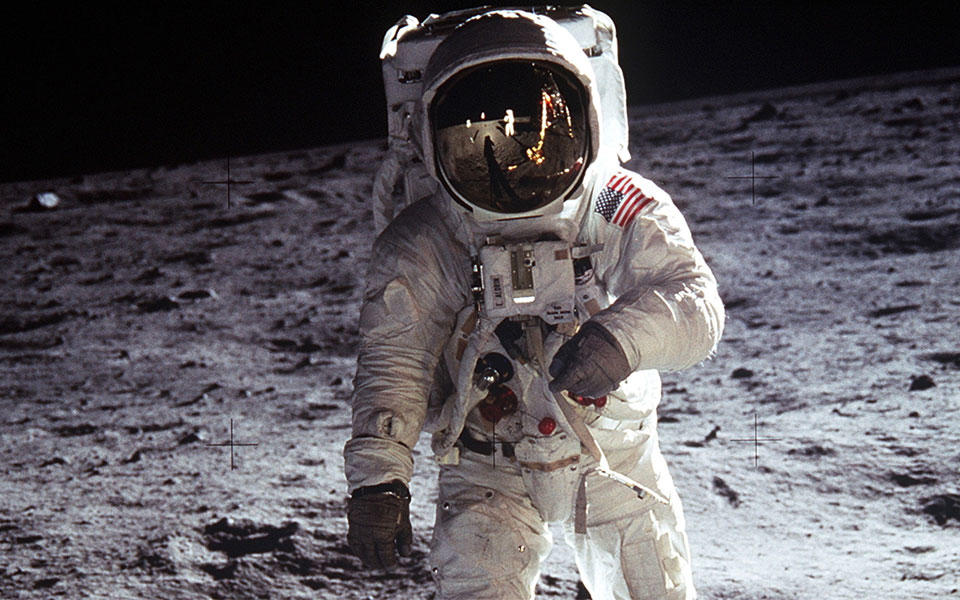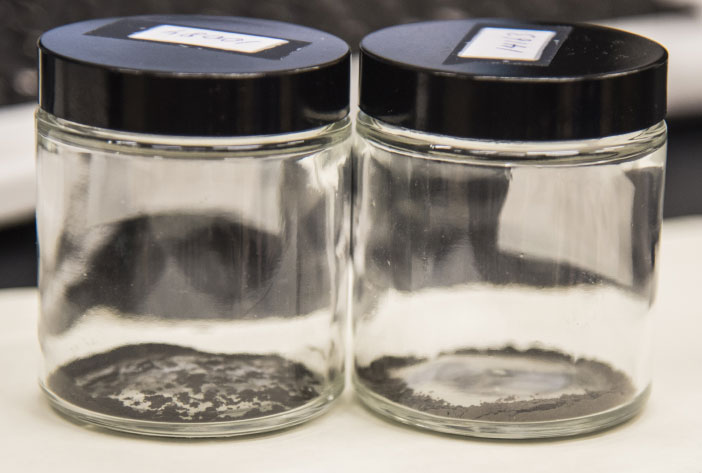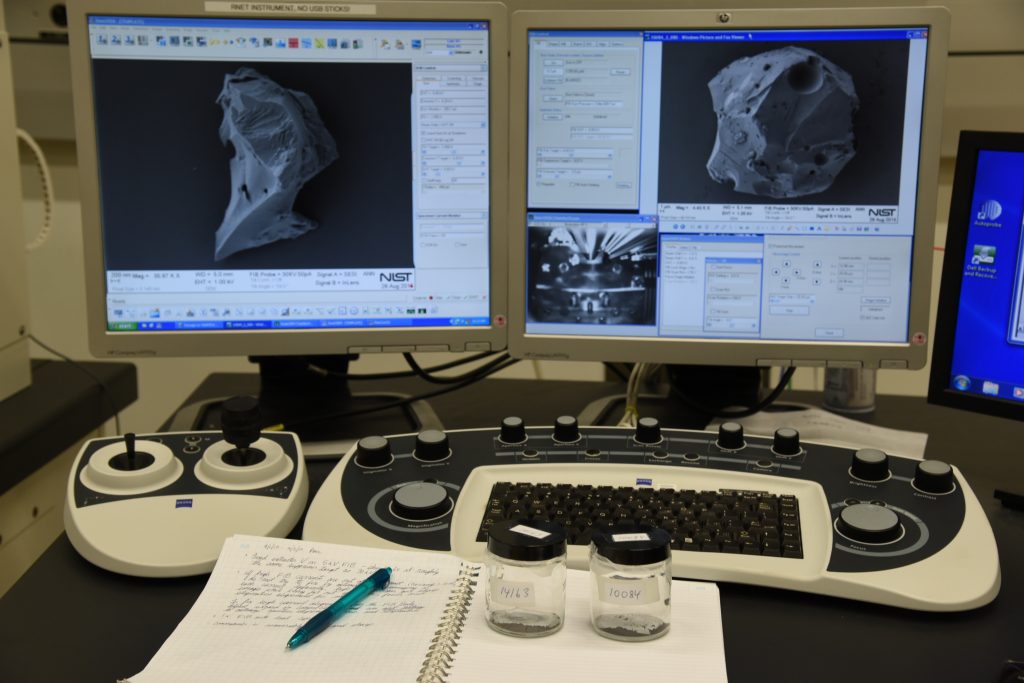Taking Measure
Just a Standard Blog

Astronaut Buzz Aldrin on the surface of the moon in 1969.
I’ve worked with many valuable materials in my career. Precious metals like gold and platinum, rare engineered nanomaterials, and fragile gemstones nearly as old as the Earth itself. But the unassuming jars of fine gray-brown powder I found myself holding last year left them all in the dust, so to speak.
I think I probably kicked up some dust, too, when my colleague Ed Garboczi called to ask if I wanted to help him make some measurements of particles that the Apollo 11 and 14 astronauts had collected during their lunar landings.
After all, when you get a call like that, you don’t walk, you run.
Ed, a NIST Fellow and researcher in the Material Measurement Laboratory, and Jay Goguen of the Jet Propulsion Laboratory (JPL) at NASA, had brought priceless moon dust, or lunar regolith as we vicarious astronauts call it, to NIST in order to measure the particles’ 3-D shape and size distribution.
When I was finally over being moonstruck, we got down to work formulating a research plan to make the measurements that NASA needed.
Hidden in the Dust
The Apollo program ended in 1972 and, while most people think that we know everything there is to know about the moon—and moon dust—by now, the truth is there’s still a lot left to learn. Although we certainly have a good understanding of the moon’s geology and the chemical makeup of moon dust, until recently no one has had the ability to make careful measurements of the three-dimensional shapes of the actual real-life particles at high resolution and in numbers large enough to ensure our measurements are truly representative of what was in the jars.
I know what you’re thinking. The fact that the dust comes from the surface of the moon is pretty cool, but why would anyone want to know about the sizes and shapes of particles you can barely see?

Well, it turns out that astronomers learn a lot about faraway objects by simply studying how they reflect light. For example, we learned that the clouds on Venus are made of micrometer-sized (millionth of a meter) sulfuric acid droplets by studying the polarization (think of it like the orientation of the light wave relative to its direction of travel) of the light reflected by the planet. For celestial objects that lack an atmosphere, like our moon, asteroids, and other moons in our solar system, the reflected light can provide information about what the surface is made of and its texture.
Using new size and shape measurements and modern computer modeling methods, we can connect the ‘ground truth’—the actual lunar soil particle properties—to the reflected light that astronomers measure with their telescopes.
Rainbows on the Moon
Moon dust is very different from any soil on Earth. It was formed by billions of years of meteor impacts that not only pulverized the rocks, but also melted them to form tiny shards and droplets of glass.
The size of these particles is important because particles much smaller than a wavelength of light will reflect light in all directions relatively uniformly while particles much larger than a wavelength of light will reflect light in certain directions more strongly than others.
Particle shape also influences this directional pattern of reflected light, especially for particles that are wavelength-sized.
For example, if the moon were covered in perfectly spherical, uniformly sized dust particles, we would see it cycle through a rainbow of colors as it passed through its phases every month. This is because those marble-like particles would reflect the light much like spherical rain drops create rainbows here on Earth by reflecting the colors (wavelengths) of sunlight in slightly different directions.

Here at NIST, we’re able to make careful measurements of the 3-D shapes and size distributions of moon dust using a combination of methods that employ both X-rays and electron beams. Ed uses a technique called X-ray computed tomography (XRCT), which allows him to get detailed 3-D shape and size information on a large number of particles at the same time, in size ranges from about 50 micrometers down to about 7 micrometers—roughly the same size as a human red blood cell and almost 15 times smaller than the diameter of an average human hair.
Due to some limitations of the technique, though, it’s impossible for him to measure anything smaller than that. And although it sounds almost unbelievable, it turns out that particles 7 micrometers in size and smaller can still influence the way that light scatters off the moon!
That’s where I come in. Using a technique called scanning electron microscopy, I am able to take pictures of small moon dust particles in sizes down to even the nanometer scale. And while I don’t actually convert my 2-D images into full 3-D mathematical models for the particle shape as Ed does with his XRCT data, I can still provide a lot of useful information in the study. For example, we can tell if the particles that Ed can’t measure using his technique are just smaller versions of the ones that he can measure.

Once we’re done, NASA JPL researchers can use the data we’ve gathered about the 3-D shape and size of the moon dust particles to more reliably determine the composition and physical state of distant asteroids, comets, and the moons of other planets.
To Infinity and Beyond
Just like millions of kids, Ed and I had both wanted to be astronauts when we grew up. Unfortunately, only a handful have the opportunity to ride a rocket into space, and fewer still ever had the chance to walk on the moon. In fact, the last astronaut to do so, Eugene Cernan, died just recently. Measuring moon dust is as close as we’ll ever get to going to the moon itself, but the chance to “touch” that history and be part of the ongoing process of discovery is truly awe-inspiring.
It’s something I’ll tell my grandkids about, and probably anyone else who’ll listen.
With any luck, the measurements we made will help to study the surface of a planet that people may walk on someday.
I hope I’m alive to see it.
About the author
Related Posts
Comments
- Reply





